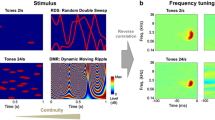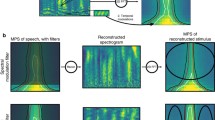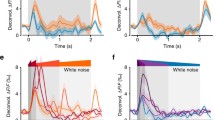Abstract
The existence of spectro-temporal receptive fields and evidence for population coding in auditory cortex motivate the development of such models, that explicitly operate in the time-frequency domain and are based on a pulsed neural network. In presenting such a model, a formal connection of the fields of Time Frequency Analysis and Pulsed Neural Networks is established. The resulting neural time-frequency signal representation is shown to be representable as a signal-dependent overcomplete dictionary. It is derived from neural population coding. Signal decomposition and filtering effects are presented, indicating obvious technical applications of the proposed model.
Similar content being viewed by others
References
Allen J (1977) Short term spectral analysis, synthesis, and modification by discrete fourier transform. IEEE Transactions on Acoustics, Speech, Signal Processing ASSP-25(3): 235–238
Bohte SM (2003) Real neurons spike. In: Proceedings of the Workshop on the Future of Neural Networks, FUNN2003. Eindhoven, The Netherlands
Cohen L (1995) Time-Frequency Analysis, Signal Processing Series. Prentice-Hall
Cunningham GS and Williams WJ (1994) Fast implementations of generalized discrete time-frequency distributions. IEEE Transactions on Signal Processing 42: 1496–1508
de Charms, R. and Merzenich MM (1996) Primary cortical representation of sounds by the coordination of action-potential timing. Nature 381: 610–613
Depireux DA, Simon JZ, Klein DJ and Shamma SA (2001) Spectro-temporal response field characterization with dynamic ripples in ferret primary auditory cortex. Journal of Neurophysiology 85: 1220–1234
DeWeese MR and Zador AM (2002) Binary coding in auditory cortex. In: Proceedings of the 16th Annual Conference on Neural Information Processing Systems (NIPS 2002), Vol. 15 of Advances in Neural Information Processing Systems. MIT Press
Eckhorn R, Reitboeck HJ, Arndt M and Dicke P (1990) Feature linking via synchronization among distributed assemblies: Simulations of results from cat visual cortex. Neural Computation 2: 293–307
Flanagan JL (1972) Speech Analysis, Synthesis, and Perception. Springer-Verlag, New York
Franosch J-MP, Kempter R, Fastl H and van Hemmen JL (2003) Zwicker tone illusion and noise reduction in the auditory system. Phys. Rev. Lett. 90: 178103
Gerstner W (1998) Populations of spiking neurons. In: Maass W and Bishop C (eds) Pulsed Neural Networks, pp. 261–295. MIT Press
Hahnloser RHR, Kozhevnikov AA and Fee MS (2002) An ultra-sparse code underlies the generation of neural sequences in a songbird. Nature 419: 65–70
Harris FJ (1978) On the use of windows for harmonic analysis with the discrete fourier transform. Proceedings of the IEEE 66(1): 51–84
Heil P (1997) Auditory onset responses revisited. I. First-spike timing. Journal of Neurophysiology 77(5): 2616–2641
Hlawatsch F and Matz G (2002) Linear time-frequency filters. In: Boashash B (ed) Time-Frequency Signal Analysis and Processing. Prentice Hall, Englewood Cliffs (NJ)
Hodgkin AL and Huxley AF (1952) A quantitative description of membrane current and its application to conduction and excitation in nerve. Journal of Physiology 117: 500–544
Horn D and Opher I (1999) Collective excitation phenomena and their applications. In: Bishop CM (eds) (1999) Pulsed Neural Networks. MIT Press (Maass and Bishop, 1999), pp. 297–320
Johnson JL and Padgett ML (1999) PCNN models and applications. IEEE Transactions on Neural Networks 10(3): 480–498
Kistler W and Gerstner W (2002) Stable propagation of activity pulses in populations of spiking neurons. Neural Computation 14: 987–997
Klein D, König P and Körding KP (2003) Sparse spectrotemporal coding of sounds. EURASIP Journal on Applied Signal Processing 7: 659–667
Klein DJ, Depireux DA, Simon JZ and Shamma SA (2000) Robust spectrotemporal reverse correlation for the auditory system: optimizing stimulus design. Journal of Computational Neuroscience 9(1): 85–111
Körding KP, König P and Klein D (2002) Learning of sparse auditory receptive fields. In: Proceedings of the International Joint Conference on Neural Networks (IJCNN 2002). Honolulu, Hawaii
Lewicki M and Sejnowski T (2000) Learning overcomplete representations. Neural Computation 12(2): 337–365
Maass W (1999) Computing with spiking neurons. In: Maass W and Bishop CM (eds) Pulsed Neural Networks, pp. 55–85. MIT Press
Maass W and Bishop CM (eds) (1999) Pulsed Neural Networks. MIT Press
Machens CK, Wehr M and Zador AM (2002) Spectro-temporal receptive fields of subthreshold responses in auditory cortex. In: Proceedings of the 16th Annual Conference on Neural Information Processing Systems (NIPS 2002), Vol. 15 of Advances in Neural Information Processing Systems. MIT Press
Mallat S and Zhang Z (1993) Matching pursuit with time-frequency dictionaries. IEEE Transactions on Signal Processing 41(12): 3397–3415
Olshausen B and Field D (1997) Sparse coding with an overcomplete basis set: a strategy employed by V1?. Vision Research 37: 3311–3325
Perrinet L and Samuelides M (2002) Sparse image coding using an asynchronous spiking neural network. In: Proceedings of the European Symposium on Artificial Neural Networks, ESANN'2002, pp. 313–318. Bruges, Belgium
Perrinet L, Samuelides M and Thorpe S (2003) Emergence of filters from natural scenes in a sparse spike coding scheme. In: Proceedings of the Workshop on the Future of Neural Networks, FUNN2003. Eindhoven, The Netherlands
Portnoff MR (1980) Time-frequency representation of digital signals and systems based on short-time fourier analysis. IEEE Transactions on Acoustics, Speech, Signal Processing ASSP-28: 55–69
Qian S (1999) Joint time-frequency analysis. IEEE Signal Processing Magazine 16(2): 52–67
Qian S and Chen D (1993) Signal representation in adaptive Gaussian functions and adaptive spectrogram. In: Proceedings of the 27th Annual Conference on Information Sciences and Systems, pp. 59–65
Schamschula MP, Johnson JL and Inguva R (2000) Image processing with pulse coupled neural networks. In: Proceedings of the 2nd International Forum on Multimedia and Image Processing, World Automation Congress. Maui, Hawaii
Shamma SA (1995) The Handbook of Brain Theory and Neural Networks, Chapt. Auditory Cortex, pp. 110–115. MIT Press
Taylor JG (ed) (1998) Image Processing using Pulse-Coupled Neural Networks, Perspectives in Neural Computing. Springer-Verlag
van Son RJJH, Binnenpoorte D, van den Heuvel H and Pols LCW (2001) The IFA corpus: a phonemically segmented Dutch ‘open source’ speech database. In: Proceedings of Eurospeech 2001. Aalborg, Denmark
Volkmer M (2003) Neural speech enhancement in the time-frequency domain. In: Proceedings of the 2003 IEEE Signal Processing Society International Workshop on Neural Networks for Signal Processing, NNSP2003, pp. 617–627. Toulouse, France
Xia X (1998) A quantitative analysis of SNR in the short-time Fourier transform domain for multicomponent signals. IEEE Transactions on Signal Processing 46: 200–203
Zaruda JM (ed) (1999) Special Issue on Pulse Coupled Neural Networks, Vol. 10 of IEEE Transactions on Neural Networks. IEEE Neural Networks Council
Author information
Authors and Affiliations
Rights and permissions
About this article
Cite this article
Volkmer, M. A pulsed neural network model of spectro-temporal receptive fields and population coding in auditory cortex. Natural Computing 3, 177–193 (2004). https://doi.org/10.1023/B:NACO.0000027754.87207.18
Issue Date:
DOI: https://doi.org/10.1023/B:NACO.0000027754.87207.18




